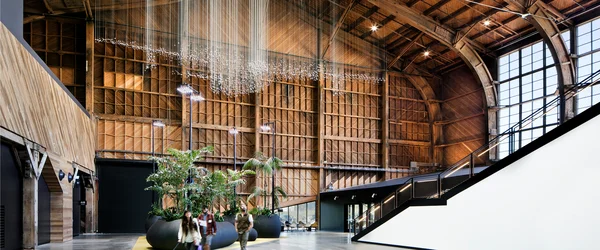Welcome to St. John’s Terminal, our new home in New York City
On Monday, February 26 we’ll welcome thousands of Googlers to our newest office in New York: St. John’s Terminal. The new structure was built on top of the original rail terminal from the 1930s that served as the end point for what’s now the High Line. Exposed rail beds along the northern facade nod to this history, while the sustainable design and innovative workspaces are focused on the future. This building represents our latest thinking about how we can best work together with our clients, partners and each other.
Over 14,000 Googlers now call New York home, which is up from 7,000 employees in 2018 when we first announced our involvement with the project. We’ve not only kept our pledge to double our New York workforce over the decade that followed that announcement, but we’ve done it in half the time. It’s a testament to New York’s vibrancy, diverse talent pool and world-class institutions that keep us rooted here.
A workplace designed for teams
The way the world works has changed, but the office remains an essential part of Google’s culture. Our research shows that innovation is born from small, tight-knit teams working together to do big things. So at St. John's Terminal we’ve applied research about how Googlers work today to create a workplace that is designed around teams first.
St. John’s Terminal will feature a new shared neighborhood seating model. Instead of every employee having their own assigned desk, every team will have an assigned area that acts as its home base. These neighborhoods aren’t one-size-fits-all: they have a variety of desks, meeting rooms, phone booths and communal tables for the different types of work Googlers do every day. In other offices where we’ve piloted shared neighborhoods, Googlers have told us that these new spaces foster greater levels of social connection and team cohesion.
At St. John's Terminal we’ve applied the latest research on how Googlers work today to create a workplace that is designed around teams first.
These neighborhoods aren’t one-size-fits-all: they have a variety of desks, meeting rooms, phone booths and communal tables for the different types of work Googlers do every day.
We’ve piloted shared neighborhoods in some of our other offices, and Googlers have told us that these new spaces foster greater levels of social connection and team cohesion.
Googlers have also shared they want more choice in where and how they work throughout the day, rather than being tethered to a desk. So in addition to shared neighborhoods, we’ve dedicated just as much footprint to a range of communal spaces where any Googler can work, including those visiting New York from our other offices. These spaces — which include expansive work lounges on every floor, cafes, terraces, micro-kitchens and more — have what Googlers need to do their jobs including ergonomic seats, generous work surfaces and access to power outlets. This creates a variety of work environments — from those that feel like a buzzing coffee shop, to a breezy outdoor garden, to a quiet library with sweeping views of the Hudson.
In addition to shared neighborhoods, we’ve dedicated just as much of St. John’s Terminal to a range of communal spaces that don’t have traditional desks, but rather serve as common spaces where any Googler can work, including those visiting New York from our other offices.
These communal spaces include expansive work lounges on every floor, cafes, terraces, micro-kitchens, and more.
These communal spaces offer Googlers an enormous variety of work environments, from those that feel like a buzzing coffee shop, to a breezy outdoor garden, to a quiet library with sweeping views of the Hudson.
A hub for collaboration with our clients and partners
It only makes sense that the North American headquarters for Google’s Global Business Organization would be in New York, since the city is also home to so many of our clients and partners. Our design teams conducted extensive research with members of our sales organization to understand what would create an environment that contributed to our shared success with partners and clients. One of the biggest insights was that providing ample, dedicated space where clients can come in and spend the day collaborating shoulder-to-shoulder with Googlers is key to understanding their needs and working together to find creative solutions.
Multiple floors are dedicated to this kind of partner-based work with an events hub, cafe space and breakout rooms to serve every size and type of client. Google’s business community partners are essential to reaching our broader company mission to make the world’s information universally accessible and helpful: St. John’s Terminal will help us achieve that, together.
St. John’s Terminal has been designed from the ground up as a place to collaborate with partners who rely on our tools to grow their business.
Multiple floors of St. John’s Terminal are dedicated to this kind of partner-based work, with an events hub, cafe space, and breakout rooms to serve every size and type of client.
Providing ample, dedicated space where clients can come in and spend the day collaborating shoulder-to-shoulder with Googlers is key to understanding their needs and working together to find creative solutions.
A sustainable design that honors the site’s history
We’ve worked to make sure Google’s New York offices enhance the communities where we operate instead of towering over them. One of the ways we do this is by adapting historic buildings to be reused for our offices, like Pier 57 and Chelsea Market. The original St. John’s terminal structure serves as the base of our new office, but we removed the portion that loomed over Houston street, removing a dark tunnel and restoring the connection between the Hudson Square neighborhood and the waterfront.

Adapting the existing structure and foundation is projected to save approximately 78,400 metric tons of carbon dioxide equivalent emissions when compared to creating a new structural foundation. That’s equivalent to removing roughly 17,000 cars from the road for a year. 1
The building has 1.5 acres of vegetation at street level, in rail bed gardens, and on terraces, redefining what “green space” means for commercial real estate in New York. This not only enhances the experience for occupants but also benefits the local ecology. Over 95% of the exterior plants at St. John’s Terminal are native to New York State, reknitting the building into the local system. Working with NYC Audubon, we’ve observed over 40 bird species using the habitat created at St. John’s Terminal — including birds fueling up for a trans-Atlantic migratory flight. The building also incorporates solar panels, rainwater retention and wood that was reclaimed from the Coney Island boardwalk after Hurricane Sandy.
The building has 1.5 acres of vegetation at street level, in rail bed gardens, in window boxes, and on terraces, redefining what “green space” means for commercial real estate in New York. Exposed rail beds along the northern facade nod to the history of St. John's Terminal.
The building also incorporates solar panels, rainwater retention and wood that was repurposed from the Coney Island boardwalk after Hurricane Sandy.
Over 95% of the exterior plants at St. John’s Terminal are native to New York State, reknitting the building into the local system.
St. John’s Terminal represents the next chapter in Google's New York story. We’re excited to start writing it together with our clients, partners, and neighbors as we officially open the building.







